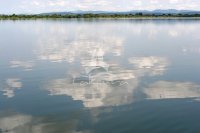Polonnaruwa historical city

Polonnaruwa,Sri Lanka's splendid medieval capital was established as the first city of the land in the 11th Century, A.D. It replaced anuradapuraya plundered made desolate, and laid hopelessly bare to the invading armies from South India. Three Kings dominate the annals of the city and the period.
The city reached a dazzling but pitifully brief zenith in the 12th century and though ravaged by invasion in the centuries following, much evidence remains of the old grandeur and glory.
The ruins of the ancient city stand on the east shore of a large artificial lake, the Topa Wewa Lake, or Parakrama Samudra (the Sea of Parakrama), created by King Parakramabahu I (1153-86), whose reign was Polonnaruwa's golden age. Within a rectangle of city walls stand palace buildings and clusters of dozens of dagobas, temples and various other religious buildings.
A scattering of other historic buildings can be found to the north of the main complex, outside the city walls and close to the main road to Habarana and Dambulla.
To see many of the relics excavated from the site such as the stone lion which once guarded the palace of King Nissanka Malla, or the fine Hindu bronzes unearthed from the ruins of the Siva Devale Temple - you may have to visit the National Museum in colombo, where they are kept. However, with the opening of the new Polonnaruwa Visitor Information Centre and its museum in 1998/9 some of the key exhibits were scheduled to return to the place where they were discovered.
Parakrama Samudraya in Polonnaruwa
Parakrama Samudra
(Sinhala: Sea of Parakrama) built by King Parakramabahu the great,
largest ancient man-made rainwater reservoir in Sri Lanka dominates the
western flank of the polonnaruwa
district. The great reservoir spreading an area of 2500 hectars and
having a capacity of 134 million cubic meters is the lifeline to the
agricultural district of Polonnaruwa and surroundings. The city of
Polonnaruwa, 122 hectars in extent, spreading out to a distance of 5km
from north to south and 3km from east to west, is also the beneficiary
of cooling breezes of Parakrama Samudra.
Close by Parakrama Samudra are the ruins of the Kings
(King Nissanka Malla) Council Chamber on whose pillars are inscribed the
status and titles of various officials of the kingdom.
Statue of King Parakramabahu in Polonnaruwa
On the Southern side of the Parakrama Samudra and South of picturesque lakeside Rest house is another well known polonnaruwa monument: a striking rock craved statue of a man of noble disposition holding a stack of manuscripts written on ola.
The statue has generated speculations and arguments concerning the
identification. The archeologists haven't arrived at a concrete
conclusion.The sculpture that rises to a height of 3.5m is believed to
be that of King Parakramabahu the great.It could also
very well be a representation of the sage Pulasti, after whom the city
was named Pulastinagara. Pulastinagara (Sinhala: City of Pulasti) is the
pali version of the Sinhala name Polonnaruwa.
Palace of King Parakramabahu in Polonnaruwa
Enclosed by ramparts four leagues long and seven leagues wide the Royal Citadel has many interesting monuments. Palace of King Parakramabahu
must have been an imposing edifice once, richly decorated and seven
storeys high: the remaining walls of the palace are of extra-ordinary
thickness and the drainage system is intriguing. A little further on is
the handsome royal bath, the Kumara Pokuna. Across the way is the
beautiful Royal Audience Hall - embellished with lion portals, graceful
pillars and a moonstone. (a delicately carved stepping stone).
The structural techniques of this period were the same as those of the Anuradhapura
period, but there was a greater use of lime mortar, which enabled the
building of brick structures of dimensions never before attempted.
Potgul Vehera in Polonnaruwa
At the southern end of the city,i.e. 100m south of the statue of King
Parakramabahu, outside the Royal Garden of Nandana Uyana is the Potgul Vehera, or the Library Monastery’.
A central square terrace houses the principal monument, a circular shrine or library where the sacred books were deposited. It is surrounded four small dagobas.
The superior acoustics of Potgul Vehera leads to the conculsion the library had doubled up as an auditorium on occasions to read the books, read the tenets of Buddhism and chant the blessings called "Pirith"
The buildings called Potgul Vihara or library utilized for the same purposes as the shrine at polonnaruwa can be seen in some of the Buddhist monuments too.
A central square terrace houses the principal monument, a circular shrine or library where the sacred books were deposited. It is surrounded four small dagobas.
The superior acoustics of Potgul Vehera leads to the conculsion the library had doubled up as an auditorium on occasions to read the books, read the tenets of Buddhism and chant the blessings called "Pirith"
The buildings called Potgul Vihara or library utilized for the same purposes as the shrine at polonnaruwa can be seen in some of the Buddhist monuments too.






No comments:
Post a Comment